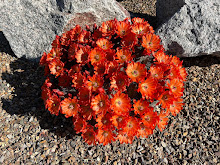 If I hadn't been in the bathroom drying my hair
If I hadn't been in the bathroom drying my hairI wouldn't have caught a glimpse of a furry tail passing by the window
and I wouldn't have got up to take a closer look at the fox
and I wouldn't have seen the flower on the lace cactus, Echinocereus reichenbacci,
 and if I hadn't mentioned it to D he wouldn't have told me that there was another lace cactus blooming out in the front,
and if I hadn't mentioned it to D he wouldn't have told me that there was another lace cactus blooming out in the front, and if I hadn't gone out to look at it I wouldn't have seen the buds on this clump of cactus, Escobaria missouriensis about to burst into flower any day,
and if I hadn't gone out to look at it I wouldn't have seen the buds on this clump of cactus, Escobaria missouriensis about to burst into flower any day, and if I hadn't gone out to check on it the next morning I wouldn't have seen the flower on the rain lily that appeared overnight (The plants that MSS gave me a few weeks ago) It was such a perfect white bloom.
and if I hadn't gone out to check on it the next morning I wouldn't have seen the flower on the rain lily that appeared overnight (The plants that MSS gave me a few weeks ago) It was such a perfect white bloom. And if I hadn't gone out to photograph the cactus again a few hours later I wouldn't have disturbed the three deer that hang about all the time,
And if I hadn't gone out to photograph the cactus again a few hours later I wouldn't have disturbed the three deer that hang about all the time,











































































